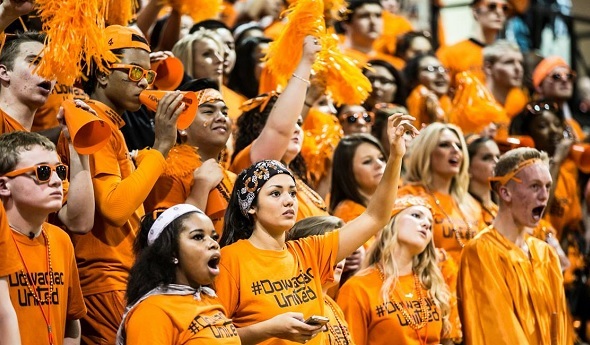
BOTF VII: Do You Accept the Challenge?
December 12, 2017
By Geoff Kimmerly
Second Half editor
The MHSAA Student Advisory Council's "Battle of the Fans VII" is set to kick off at high schools all over our state. An expanded contest format will allow more schools to compete for the title of best high school student section in Michigan.
Contenders need to keep just one question in mind: Are you prepared to accept the challenge?
For the first time in BOTF history, nine schools will advance to a second round of "challenge" competition, with three finalists then selected for student section visits during the second half of this winter season.
To apply, schools are invited to submit a short video, via YouTube, of their cheering sections in action. Video submissions should be between 90 seconds and three minutes long and explain how that section meets the following contest criteria: positive sportsmanship, student body participation, school spirit, originality of cheers, organization of the group, student section leadership and fun.
The deadline for student-submitted video applications is noon Jan. 13. Nine semifinalists then will be chosen – three each from Class A, Class B and Class C/D – to partake in a two-week challenge where each will be required to complete 10 tasks further showing why they should be chosen as Michigan’s best student section. From those nine, three finalists then will be selected by the Student Advisory Council and visited on a home game night by MHSAA staff and Advisory Council representatives.
The MHSAA will produce a video of that finalist after each visit, with the champion being selected by the Student Advisory Council based in part on activity on the MHSAA’s social media sites.
This year’s winner will be announced Feb. 23 and recognized March 23 at the Breslin Center.
Frankenmuth was named last year’s champion and presented with a banner during the MHSAA Boys Basketball Finals at Michigan State University’s Breslin Center. Sections from Boyne City, Charlotte, Petoskey and Traverse City West also were finalists.
“Battle of the Fans has enjoyed a great run these first six years and provided plenty of examples that help us teach students statewide how to celebrate school spirit,” said Andy Frushour, MHSAA director of brand management and advisor to the Student Advisory Council. “By putting a fresh spin on the contest this winter, we’ll be able to have more schools involved in the competition for a longer period of time, and we’re looking forward to the creativity of our students as they complete these challenges – which will allow us to showcase more of the great work so many are doing to support their classmates not just on one night, but all school year long.”
Rules, directions for submitting videos, plus links to coverage of finalists from the first six years of the contest can be found on the MHSAA Website BOTF page. This year’s finalist videos, plus the announcement of the 2017-18 winner, will be published on Second Half.
The Student Advisory Council is made up of eight seniors and eight juniors, who each serve two-year terms. The Council acts as the voice of Michigan's student-athletes; it serves as a student sounding board for the MHSAA's Representative Council, assists in planning Sportsmanship Summits, Captains Clinics and other student leadership events; participates in a yearly focus group about the state of high school sports for Michigan State University's Institute for the Study of Youth Sports and assists with medal ceremonies at MHSAA championship events.
PHOTO: Dowagiac had us on the move during its BOTF championship run in 2015. VIDEO: Below, Frankenmuth showed its spirit in 2017 in becoming the first two-time BOTF champion.

Sportsmanship and Success in Soccer
August 16, 2012
Ralph Polson, president of the National Soccer Coaches Association of America (NSCAA), reports in the July/August 2012 Soccer Journal that there is a strong statistical link between sportsmanship and success in intercollegiate soccer. He cites the work of Tim Lenahan, head men’s coach at Northwestern University, who compiled total fouls, yellow cards and red cards for the 2011 season to create a “Fair Play Rating” (FPR).
Polson reports that 12 of the 20 teams with the top FPR made the NCAA tournament, while only one of the teams in the bottom 20 did. Of course, this is a statistical link, not necessarily cause and effect. But here’s how Mr. Polson concludes his column:
“How should we interpret this data? One direction is toward more disciplined teams. It seems to me the more a culture of sportsmanship and fair play is established, the more likely any team is to demonstrate the consistency needed for success. The data suggests those teams without entrenched standards, with respect to on-field behavior, should anticipate a higher likelihood of failure in today’s highly competitive environment.
“Play within the spirit of the game and more than just a win may be gained; play against the spirit of the game and much more than just a game may be lost.”
Dr. Brian Crossman, chair of the NSCAA Ethics Committee, contributes this to the discussion in the same issue of Soccer Journal:
“A five year study from 2007 to 2011 of almost 4,700 intercollegiate soccer matches in which only one player was red-carded during the match showed a strong likelihood that the player’s team would lose. Teams that had one player red-carded lost 67 percent of the matches, tied 10 percent of the matches and won 23 percent of the matches. In other words, a team that had a player red-carded at any time during the match was three times more likely to lose the match than win it. Taking steps to encourage clean and fair play, and thus to reduce the likelihood of having players ejected, will pay dividends in sportsmanship and should improve your team’s won-loss record.”
For more, go to www.nscaa.com.

